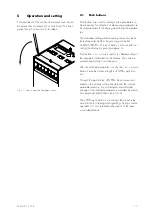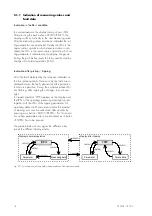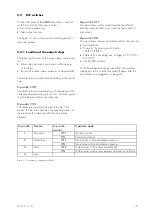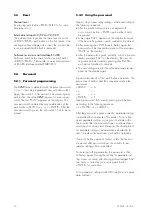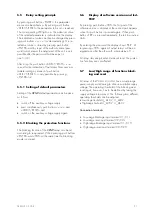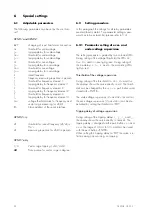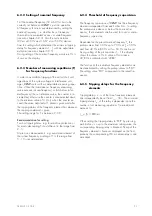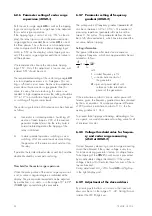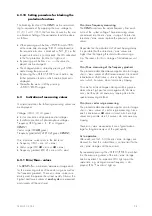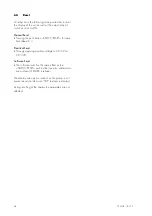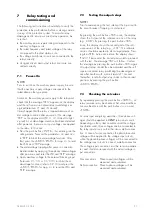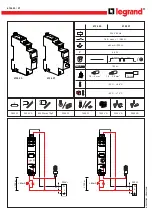
12
TB XRN2 02.00 E
A reliable criterion of detecting mains failure is the
measurement of the rate of change of frequency df/dt.
Precondition for this is a load flow via the mains cou-
pling point. At mains failure the load flow changing
then spontaneously leads to an increasing or decreas-
ing frequency. At active power deficit of the internal
power station a linear drop of the frequency occurs
and a linear increase occurs at power excess. Typical
frequency gradients during application of "mains de-
coupling" are in the range of 0.5 Hz/s up to over
2 Hz/s. The
XRN2
detects the instantaneous frequency
gradient df/dt of each mains voltage period in an in-
terval of one half period each. Through multiple evalua-
tion of the frequency gradient in sequence the continu-
ity of the directional change (sign of the frequency
gradient) is determined. Because of this special measur-
ing procedure a high safety in tripping and thus a high
stabilty against transient processes, e.g. switching pro-
cedure are reached. The total switching off time at
mains failure is between 60 ms and 80 ms depending
on the setting.
4.6
Vector surge supervision (
XRN2-1
)
The vector surge supervision protects synchronous gen-
erators in mains parallel operation due to very fast de-
coupling in case of mains failure. Very dangerous are
mains auto reclosings for synchronous generators. The
mains voltage returning after 300 ms can hit the gen-
erator in asynchronous position. A very fast decoupling
is also necessary in case of long time mains failures.
Generally there are two different applications:
a)
Only mains parallel operation no single opera-
tion:
In this application the vector surge supervi-
sion
protects the generator by tripping the genera-
tor
circuit breaker in case of mains failure.
b)
Mains parallel operation and single operation:
For this application the vector surge supervision
trips the mains circuit breaker. Here it is insured
that the gen.-set is not blocked when it is required
as the emergency set.
A very fast decoupling in case of mains failures for syn-
chronous generators is known as very difficult. Voltage
supervision units cannot be used because the synchro-
nous alternator as well as the consumer impedance
support the decreasing voltage.
For this the mains voltage drops only after some
100 ms below the pickup threshold of voltage supervi-
sion relays and therefore a safe detection of mains auto
reclosings is not possible with this kind of relay.
Frequency relays are partial unsuitable because only a
highly loaded generator decreases its speed within
100 ms. Current relays detect a fault only when short-
circuit type currents exist, but cannot avoid their develop-
ment. Power relays are able to pickup within 200 ms, but
they cannot prevent power to rise to short-circuit values
too. Since power changes are also caused by sudden
loaded alternators, the use of power relays can be
problematic.
Whereas the
XRN2-1
detects mains failures within
60 ms without the restrictions described above because
they are specially designed for applications where very
fast decoupling from the mains is required.
Adding the operating time of a circuit breaker or con-
tactor, the total disconnection time remains below
150 ms. Basic requirement for tripping of the genera-
tor/mains monitor is a change in load of more than 15
- 20% of the rated load. Slow changes of the system
frequency, for instance at regulating processes (adjust-
ment of speed regulator) do not cause the relay to trip.
Trippings can also be caused by short-circuits within the
grid, because a voltage vector surge higher than the
preset value can occur. The magnitude of the voltage
vector surge depends on the distance between the
short-circuit and the generator. This function is also of
advantage to the Power Utility Company because the
mains short-circuit capacity and consequently the en-
ergy feeding the short-circuit is limited.
To prevent a possible false tripping the vector surge
measuring can be blocked at a set low input voltage
(refer to 6.2.8). The undervoltage lockout acts faster
then the vector surge measurement.
Vector surge tripping is blocked by a phase loss so that
a VT fault (e.g. faulty VTs fuse) does not cause false
tripping.
When switching on the aux. voltage or measuring volt-
age , the vector surge supervision is blocked for 5 s (re-
fer to chapter 4.8).
Содержание XRN2
Страница 1: ...XRN2 Mains decoupling relay ...
Страница 40: ...40 TB XRN2 02 00 E ...

















